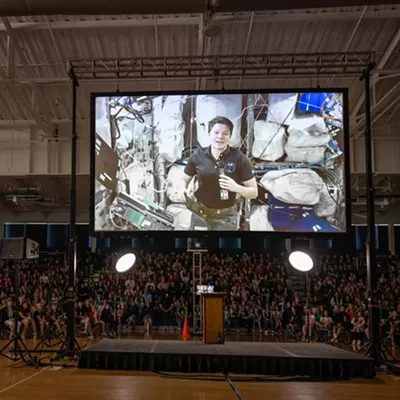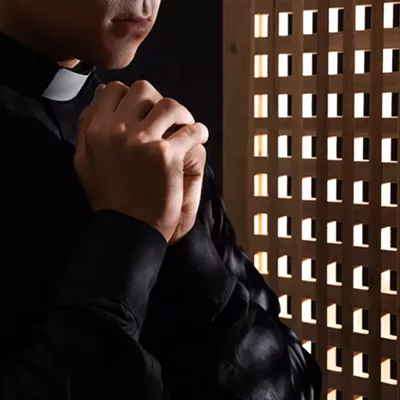Andy Wolf loved skateboarding and earned his green as a professional snowboarder during the '90s, but felt unfulfilled on the snow. He needed, he says, a way to reconcile the two loves of his sporting life. Thus was born the snowskate.
A hybrid of powder and pavement, the snowskate is perhaps the hottest new item in winter sports. Young skaters are demanding them from sport shops and at least one area ski resort, Silver Mountain, is promising to build a snowskating park this winter.
"I wanted to do something different and new, maybe not so elitist," says Wolf, a 30-year-old who liberally sprinkles his speech with skater affirmatives like "totally." Did he accomplish that with his snowskate? "For sure."
He wanted, he says,"Something that was fun, that would cross over with the things I love to do... Something that you could do around the house, that was affordable and fun to do."
A snowskate is plastic board somewhat longer than a skateboard, between about 34 and 38 inches long, and six or seven inches wide. Plastic grooves on the bottom act like a boat's keel, giving it a more stable ride than the skateboard decks, cafeteria trays, snow shovels and other implements young men have often aimed down an alpine slope.
A high-end board from Premier Snowskates, the company Wolf started in 1999, runs $99, and Spokane-area stores sell others for as low as $65 -- a fraction of what a snowboard, or even a skateboard, often costs. As Wolf says, "it's light on Mom's credit card."
The numbers suggest a genuine, if temporary, customer interest in the sport. Premier sold 5,000 boards in 1999, then 40,000 the next year. This year, they expect to double those sales, Wolf says.
In January, the Winter X-Games will feature a snowskating demonstration. According to Wolf, there's talk of adding a snowskate competition to the games in 2003.
But how big is big? That's what Jeff Boger, manager of Coeur d'Alene's new Groundzero Boardshop wants to know. Should he order 20 of these things, or 200? No one can say.
"I'm freaking right now because I don't have any in stock," Boger says when called about the new gear. The local demand surprises him, he says. He gets asked about snowskates by "literally six out of 10 people."
Wintersport Skate & amp; Ski in Spokane just began carrying a few, says manager Jason Hol. Like Boger, he's a little curious about the potential for the sport. "It's picking up interest, but I'm wondering where it's going," says Hol.
Hol and Boger see the average snowskater as a young teenager, often a skateboarder who wants to keep up with board-based tricks and rides in the winter. Perhaps a skater doesn't have the time or money to get into snowboarding, or to drive up to a mountain resort. Besides being cheap, one of snowskating's appeals is that anybody can pick one up and take it anywhere -- a sledding hill, maybe, or a city park.
"All of a sudden you can be in the city and find something to slide," says Boger.
Not that ski resorts are ignoring the trend. Schweitzer set up a weekend park for snowskaters last year that was packed, according to Boger, and about a dozen resorts around the nation are building skater parks this winter, including one at Mount Hood and Silver Mountain in North Idaho.
Silver's park will be a bowl carved out of snow and planted with boxes, rails and ramps for the skaters to do tricks from, says Pat Nowak, the resort's assistant general manager.
"We're always looking for new users of the mountain," says Nowak. "And obviously skateboarding has made a resurgence in the last few years, so it's a rapidly growing market. We would love to see those skateboarders become snowskaters."
Snowskates won't be allowed on mountain slopes, though. They lack boot bindings and tethers. They're not stable enough to handle long, speed-inducing runs, and when a skater falls, the board could easily rocket down the slopes, endangering people below.
Restrictions on mountain terrain might not matter, though, because snowskating is an urban sport at heart. Wolf got interested in the idea when he and friends would go snowboarding in the city and couldn't do skateboard-style tricks. Those spins and jumps are rendered impossible by a snowboard's length and bindings; the features that make it stable enough to handle mountain slopes make it too unwieldy for tricksters.
Snowskates are not the only snow sport offshoot to come down the slopes. There were snowboards some years ago, of course. In the mid-'90s, one Minnesota company manufactured something called "snow skates," a boot-and-blade combination based on in-line skating. That equipment never caught fire, though, and the company declared bankruptcy in 1997.
For now, though, Premier is riding smooth, with booming sales, partnerships and high-profile demonstrations. And larger, established snow sports companies like Burton and Saloman are bringing out their own versions of the 'skate.
Will the sport hiss and melt like snow on a hot stove, or find a permanent niche?
"There were people who wouldn't allow snowboarding and thought it would be a trend that would fizzle out," says Nowak, of Silver. "I think the key is, we as a snow sports industry have to continue to evolve and embrace new sports. Anytime someone goes out and plays on a snow berm somewhere and introduces [people] to snow, we're good with that."
















